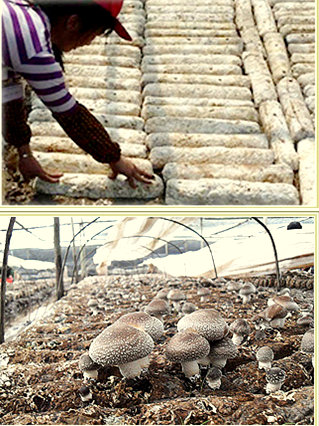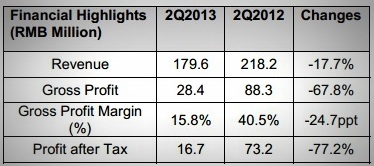SG Farmer, a shareholder of Yamada Green Resources, contributed the following insightful piece, tracing the evolution of Yamada's business and highlighting key factors that shape its profitability.

Top: Synthetic logs made from sawdust are where mushrooms are grown (picture below).
Photos: Yamada website
Photos: Yamada website
Cultivation plots are leased for seven months, between September and the next March. Between April and August, when it is too warm for mushroom to grow, farmers grow vegetables on those plots.
Shiitake mushroom grows on synthetic logs which are made from saw dust. Farmers are paid to produce the logs from sawdust generated from frutex, a plant with woody stem.
The farmers also install shading nets to protect the mushroom, look after their own cultivation plots and harvest four to five flushes of mushroom. Their reward for these efforts is dependent on the quality and amount of mushroom harvested.
Yamada now has 5,100 mu of cultivation plots, the last expansion being in 2011, when 2,500 mu were added.
Individual cultivation plots that satisfy Yamada's leasing criteria have to be of a certain size for ease of supervision and administration.
It must also be in a mildly sloping valley with flowing stream water to irrigate mushrooms continuously. The fact that the plot is not leased for the whole year rules out intensive cultivation which requires costly erection of shelves to place more synthetic logs.
In 2011, Yamada experimented with the cultivation of black fungus, a close kin of shiitake mushroom.
It leased 86 mu for the whole year, and erected shelves. The yield of this intensive cultivation is three times that of shiitake mushroom which is grown on logs placed on the ground. While the results have been encouraging, Yamada has not been able to lease more land year round.
Sawdust from Yamada eucalyptus plantations
To secure a supply of wood, Yamada decided to progressively acquire man-made non-mature eucalyptus plantations.
The last acquisition in Jan 2012, bringing the aggregate plantation area to 51,000 mu, enables the company to have enough wood to make the logs for mushroom produced from 5,100 mu of cultivation plots.
The availability of eucalyptus sawdust will obviate the need for farmers to source frutex wood. Properly-managed plantations minimise soil erosion as replanting is scheduled after felling.
Unfortunately, the company could not proceed with its first harvest of eucalyptus wood scheduled in March 2012 as the local government did not grant the required logging licence.
NextInsight's article dated 30 Dec 2012 (Key takeaways from meeting with YAMADA GREEN RESOURCES) reasoned that it would be a matter of time before Yamada obtains the licence because it would be in the interest of the community for approved plantations to supply the wood.
On 5 Feb 2013, in announcing its 2Q FY13 (ended 301 Dec 2012) results, Yamada stated that it expects to obtain the licence by early this year.
Based on the forecast in Yamada IPO prospectus, significant amounts of synthetic logs can be made from Yamada's own plantations for the next cultivation season commencing Oct 2013.
For the current cultivation season commencing Oct 12, Yamada paid a staggering RMB 234m to farmers who sourced frutex wood and made synthetic logs, 25% higher than the preceding season. This reflects rising wages in the rural areas and the scarcity value of wood.
As wood forms the bulk of the cost of the logs, considerable cash outlay will be saved in the future by Yamada.
Synthetic logs made from low-cost eucalyptus plantations are also cheaper. More importantly, the supply of wood for sawdust should diminish as Government tightens control of logging.
Bad weather in the last 2 financial years
In the past when weather was less erratic, the mushroom yield was quite constant and the considerable financial resources built up have enabled Yamada to expand its cultivation plots and eucalyptus plantations without gearing.
Unfortunately, the company could not proceed with its first harvest of eucalyptus wood scheduled in March 2012 as the local government did not grant the required logging licence.
NextInsight's article dated 30 Dec 2012 (Key takeaways from meeting with YAMADA GREEN RESOURCES) reasoned that it would be a matter of time before Yamada obtains the licence because it would be in the interest of the community for approved plantations to supply the wood.
On 5 Feb 2013, in announcing its 2Q FY13 (ended 301 Dec 2012) results, Yamada stated that it expects to obtain the licence by early this year.
Based on the forecast in Yamada IPO prospectus, significant amounts of synthetic logs can be made from Yamada's own plantations for the next cultivation season commencing Oct 2013.
For the current cultivation season commencing Oct 12, Yamada paid a staggering RMB 234m to farmers who sourced frutex wood and made synthetic logs, 25% higher than the preceding season. This reflects rising wages in the rural areas and the scarcity value of wood.
As wood forms the bulk of the cost of the logs, considerable cash outlay will be saved in the future by Yamada.
Synthetic logs made from low-cost eucalyptus plantations are also cheaper. More importantly, the supply of wood for sawdust should diminish as Government tightens control of logging.
Bad weather in the last 2 financial years
In the past when weather was less erratic, the mushroom yield was quite constant and the considerable financial resources built up have enabled Yamada to expand its cultivation plots and eucalyptus plantations without gearing.
But the good fortune has not lasted.

The company expects 3Q's output to be reasonable as "weather conditions at cultivation sites have improved since early January this year".
It is interesting to note that the very cold weather in 2Q FY13 had not reduced the output of black fungus.
One possible reason could be that within a given time, lowering the shading nets will protect more black fungus which is more intensively cultivated than mushroom.
To a certain extent, the risk of growing mushroom is lower than that of growing other crops as the shading nets can be lowered to prevent the temperature in the partially-enclosed space from dropping too much.
This raises the issue of how well the company can improve its response time to unfavourable weather. Shareholders may want to seek clarification during the upcoming AGM.
Yamada is keen to grow its processed food business, but progress has been slow. Shareholders may also ask whether the company can have a niche in this highly competitive business sector.
Previous stories:
YAMADA Visit: Mushrooming Sales, ‘Unlimited Growth’, 1.6x P/E... What Gives?
YAMADA CEO: Ex-Tour guide who built Fujian’s largest shitake mushroom farm








If the logging permit is not issued and frutex wood is used instead, the cost is likely to be higher, depressing the profit.
Note 13 of Yamada's accounts is also of relevance. The carrying value of the eucalyptus plantations is determined after discounting future cash flow at an annual rate of 10.67%.
It follows that if the valuer has been conservative in his estimation, the market value of eucalyptus wood harvested a year after the date of the accounts will be 10.67% higher.
The eucalyptus tree grows naturally with sunlight and rain, and its value enhance in the process. If mishaps such as fire or pest attack are minimised, Yamada is able to reap the benefit of a mature tree that has high wood content.
The company has previously indicated that eucalyptus trees are hardy and do not catch fire easily with thin foliage.
Yes, there will be lots of savings in cashflow but will the savings equate to bottomline profits? In other words, if Yamada pays $x for the wood, will the bottomline improve by $x as a result of the use of its own eucalyptus wood?